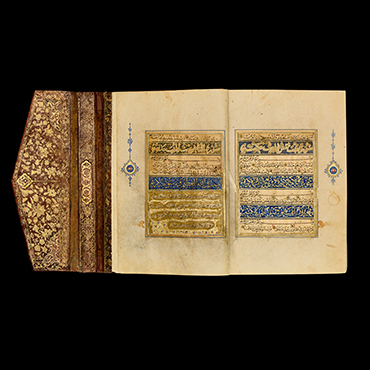A Holy Qur’an valued for centuries
This remarkable copy of the Holy Qur’an comes from a period of intense turmoil in the Islamic world, when the “classical” Abbasid period came to a violent end at the hands of Mongol invaders from the east in AH 656/1258 CE. Even the imposition of new, non-Muslim rule over the central Islamic lands, however, could not put an end to developments in Arabic calligraphy that had begun centuries earlier.
The colophon attached to this manuscript states that it was written “by the weakest of the servants of Allah Almighty, he who seeks the mercy and kindness of Allah, Yaqut al-Musta‘simi, in Shawwal 661 AH [August–September 1263 CE].” Yaqut (d. AH 697/1298 CE) is considered one of the greatest masters of Arabic calligraphy, who not only mastered but made significant reforms to the canonical “Six Pens,” especially the naskh and thuluth hands employed in this manuscript. He is also said to have taught six students, who then transmitted his teachings to their own disciples in a chain that continues to the present day. Texts copied by Yaqut have been highly sought after by rulers and other collectors since his lifetime, and many works by followers in his style have been attributed to him. The calligraphy and most of the illumination of this Qur’an is entirely in keeping with the school of Yaqut and can be safely attributed to Baghdad during his lifetime or shortly thereafter.
Like many manuscripts associated with Yaqut, this Qur’an was so highly regarded that it underwent restoration and rebinding several centuries later. The opening pages are beautifully illuminated, particularly the double-page spread featuring the first chapter and opening verses of the second, which prominently utilizes dark blue and black ink. This suggests a 10th century AH/16th-century CE embellishment, likely crafted in Bukhara, enhancing the manuscript’s exceptional beauty.
A Holy Qur’an valued for centuries
Holy Qur’an manuscript
Baghdad, Iraq, late 7th–early 8th century AH/late 13th–early 14th century CE (calligraphy), Iran, 10th century AH/16th century CE (binding, opening illumination, remounting)
Attributed to Yaqut al-Musta‘simi
Paper, ink, opaque pigments, gold, leather, h. 25.6 × w. 18 × d. 3.5 (when closed)
Furusiyya Art Foundation, R-8027

